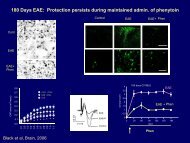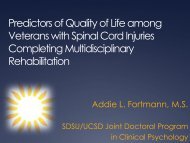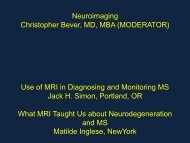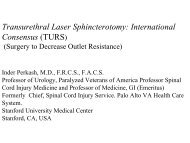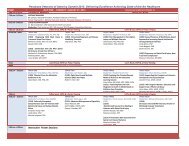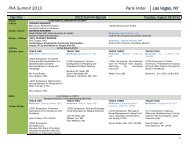You also want an ePaper? Increase the reach of your titles
YUMPU automatically turns print PDFs into web optimized ePapers that Google loves.
<strong>OCT</strong> <strong>and</strong> <strong>MS</strong><br />
PVA Summit 2012<br />
Warren L Felton III, MD<br />
Professor of Neurology <strong>and</strong> Ophthalmology<br />
Chair, Division of Neuro-Ophthalmology<br />
Associate Chair of Clinical Activities<br />
Department of Neurology<br />
Virginia Commonwealth University Medical Center<br />
Director, Neuro-Ophthalmology <strong>and</strong> Multiple Sclerosis Clinic<br />
Neurology Service<br />
McGuire Richmond Veterans Affairs Medical Center
• None<br />
Disclosures
<strong>OCT</strong> <strong>and</strong> <strong>MS</strong><br />
Objectvives<br />
• Underst<strong>and</strong> the technique of ocular<br />
coherence tomography (<strong>OCT</strong>)<br />
• Underst<strong>and</strong> the applications of <strong>OCT</strong> to<br />
multiple sclerosis<br />
• Underst<strong>and</strong> anticipated advances in <strong>OCT</strong>
Optical Coherence Tomography<br />
<strong>OCT</strong><br />
• Interferometric imaging technique<br />
• Origins in the field of optical coherence-domain<br />
reflectometry developed to localize reflections from<br />
faults in fiber optic networks<br />
• Maps depth-wise reflections of near-infrared light<br />
• Forms cross sectional images of morphological<br />
features<br />
• Micrometer scale
Characteristics of <strong>OCT</strong><br />
Physical properties<br />
• Optical analog of ultrasonography<br />
• Generates cross-sectional images by<br />
measuring back-reflected echoes of light<br />
– As the speed of light is too fast to be measured<br />
by direct detection<br />
• Current technology has 8-10 μm resolution<br />
• Newer technology has 4-6 μm resolution
<strong>OCT</strong> Instrumentation<br />
Time Domain<br />
• Michelson-type interferometer<br />
– Low-coherence-length, superluminescent diode light source<br />
• Two arms—Time Domain <strong>OCT</strong><br />
– One directs light onto the sample <strong>and</strong> collects backscattered signal<br />
– A second reference arm with a reflecting mirror, mechanically scanned to<br />
vary time delay <strong>and</strong> measure interference<br />
• Interference occurs only when the distance traveled by the light in the<br />
sample <strong>and</strong> reference arms match to within the coherence length<br />
• Data set<br />
– 2- or 3-dimentional array, representing the optical backscattering in a<br />
cross section or volume of the tissue<br />
– Displayed as<br />
• 2 dimentions<br />
• Volumetric gray-scale<br />
• False-color image
<strong>OCT</strong><br />
Ophthalmology<br />
• High-resolution imagery of subsurface<br />
retinal features<br />
• Retinal nerve fiber layer (RNFL)<br />
differentiated from other structures<br />
– RNFL horizontal orientation correlates with<br />
high reflectivity<br />
– Nuclei <strong>and</strong> other structures correlate with low<br />
reflectivity
<strong>OCT</strong><br />
Ophthalmology<br />
• Evaluates the integrity of<br />
– RNFL—average, quadrant, clock face sector<br />
– Macula—volume<br />
• RNFL thinning <strong>and</strong> macular volume<br />
reductions correspond with declines in<br />
visual function as measured by<br />
– Visual acuity (low contrast)<br />
– Visual field analysis
<strong>OCT</strong> Images of the Internal Retinal Structures<br />
Technology<br />
Frohman EM et al. (2008) Optical coherence tomography: a window into the mechanisms of multiple sclerosis<br />
Nat Clin Pract Neurol 10.1038/ncpneuro0950
Figure 1. <strong>OCT</strong> report from a a patient with <strong>MS</strong><br />
Zeiss Stratus <strong>OCT</strong>3 with software 4.0 (Carl Zeiss Meditec, Inc)<br />
Time Domain<br />
Frohman EM et al. (2008) Optical coherence tomography: a window into the mechanism<br />
of multiple sclerosis Nat Clin Pract Neurol 10.1038/ncpneuro0950
<strong>OCT</strong><br />
Fourier (Spectral) Domain<br />
• Detects light echoes by measuring the interference spectrum from<br />
an interferometer with a stationary reference arm<br />
• Spectrometer <strong>and</strong> high-speed line-scan camera record the<br />
interference spectrum<br />
• Fourier transformed to obtain the magnitude <strong>and</strong> echo time delay of<br />
the light (the axial scan)<br />
• Detects all light echoes simultaneously<br />
– Increase in sensitivity<br />
– High speed imagery<br />
– Enables retinal imaging with advanced camera technology<br />
• Commercial instruments<br />
– Axial image resolution 4-6 µm<br />
– Imaging speeds 25,000 axial scans/sec—50 fold faster than time<br />
domain <strong>OCT</strong>
<strong>MS</strong> <strong>and</strong> the Afferent Visual Pathway<br />
• <strong>MS</strong> frequently targets the anterior visual<br />
pathway<br />
• 30-77% of <strong>MS</strong> patients have optic neuritis<br />
(ON) during the course of the disease<br />
• Post-mortem studies show nearly all <strong>MS</strong><br />
patients have characteristic changes in the<br />
optic nerve <strong>and</strong> retina
<strong>OCT</strong><br />
Optic Neuritis <strong>and</strong> <strong>MS</strong><br />
• Parisi, 1999—earliest application of <strong>OCT</strong> in <strong>MS</strong><br />
– 14 <strong>MS</strong>, recovered from ON<br />
– RNFL thickness reduced (p
<strong>OCT</strong><br />
Optic Neuritis <strong>and</strong> <strong>MS</strong><br />
• Costello, 2006<br />
– <strong>MS</strong> patients 3-6 months post ON<br />
– RNFL loss of 10-40 μm<br />
• <strong>MS</strong>, ON RNFL loss across studies<br />
– Range 5-40 μm<br />
– Average 10-20 μm<br />
– RNFL loss of about 75 μm reduces the chances of visual<br />
recovery<br />
• RNFL—norms<br />
– 110-120 μm by age 15 years<br />
– 0.017% RNFL loss per year, 10-20 μm over 60 years
<strong>OCT</strong> <strong>and</strong> <strong>MS</strong><br />
Visual Disability<br />
• Visual acuity<br />
– Snellen—RNFL loss correlation in most, but not all<br />
studies<br />
– ETDRS (logarithmic scale)—RNFL loss more<br />
consistent<br />
– Low-contrast letter acuity—RNFL correlation<br />
• Visual field, automated perimetry—mixed results<br />
– Costello, 2006—75 μm RNFL loss, poor prognosis for<br />
visual field by Humphrey analyzer<br />
– Other studies did not confirm a linear relationship<br />
– <strong>OCT</strong> may detect RNFL loss below level of sensitivity<br />
of automated perimetry
<strong>OCT</strong> <strong>and</strong> <strong>MS</strong><br />
RNFL over Time<br />
• Talman, 2010<br />
– <strong>MS</strong> patients without acute ON<br />
• 593 eyes, 299 patients<br />
– <strong>OCT</strong> RNFL measurements every 6 months, mean follow-up 18<br />
months<br />
– RNFL thinning increased over time (p
<strong>OCT</strong> <strong>and</strong> <strong>MS</strong><br />
Global Clinical Scores<br />
• EDSS<br />
– Inverse relationship between RNFL thickness <strong>and</strong><br />
EDSS found in about ½ studies reported<br />
– Strongest correlation found for <strong>MS</strong> patients<br />
without acute optic neuritis<br />
– The strong correlation of RNFL in ON may mask<br />
subtle changes caused by axonal damage or<br />
trans-synaptic axonal degeneration<br />
• Multiple Sclerosis Severity Score<br />
– Naismith, 2009—no correlation found with RNFL
<strong>OCT</strong> <strong>and</strong> <strong>MS</strong><br />
Neuroimaging<br />
• Correlation between RNFL thickness <strong>and</strong><br />
MRI measures of brain atrophy in several<br />
studies, eg brain parenchymal fraction<br />
– Gordon-Lipkin, 2007<br />
– Grazioli, 2008<br />
• Consensus not yet reached on which<br />
atrophy measure is most relevant
<strong>OCT</strong><br />
<strong>MS</strong>, Gray Matter, <strong>and</strong> the Eye<br />
• Green, 2010—Ocular pathology in <strong>MS</strong><br />
– Postmortem 82 patients<br />
– Retinal atrophy with shrunken neurons<br />
– Retinal ganglion cell (RGC) dropout in 79% of<br />
eyes<br />
– Inner nuclear layer atrophy (amacrine <strong>and</strong><br />
bipolar cels) in 40% of eyes<br />
– First report of inner nuclear layer cell loss in<br />
<strong>MS</strong>
<strong>OCT</strong> <strong>and</strong> <strong>MS</strong><br />
Macula<br />
• <strong>OCT</strong> macular volume is reduced in <strong>MS</strong> patients<br />
compared to controls in most published studies<br />
• Macular volume correlated with RNFL loss in<br />
some studies<br />
• <strong>OCT</strong> macular studies provide a model for neuronal<br />
cell death—questions not resolved<br />
– What mechanisms are involved in RGC apoptosis<br />
– Could RGC apoptosis follow axonal pathology<br />
– Could RGC apoptosis be primary neuronal injury<br />
independent of axonal injury
<strong>OCT</strong> report for the macular region of the retina from the same patient with multiple<br />
sclerosis as is shown in Figure 1<br />
Frohman EM et al. (2008) Optical coherence tomography: a window into the mechanisms of multiple<br />
sclerosis Nat Clin Pract Neurol 10.1038/ncpneuro0950
<strong>OCT</strong> <strong>and</strong> <strong>MS</strong><br />
Future Developments<br />
• Polarisation-sensitive <strong>OCT</strong> (PS-<strong>OCT</strong>)<br />
– Records polarisation of back-scattered light<br />
– RNFL birefringence may precede RFNL loss <strong>and</strong><br />
potentially detect early axonal pathology<br />
• Fluorescence labeling of annexin 5, a protein<br />
that binds to a key component initiating<br />
apoptosis<br />
– Allows real-time monitoring of RGC apoptosis<br />
– A potential surrogate for neuroprotection<br />
strategies
<strong>OCT</strong> <strong>and</strong> <strong>MS</strong><br />
Future Developments<br />
• Retinal sector analysis<br />
– Certain sectors more vulnerable than others,<br />
eg maculopapillary bundle<br />
– Normal variation is significant<br />
• RNFL thickness maps, combined with<br />
Polarization Sensitive-<strong>OCT</strong><br />
• Retinal layer segmentation by SD/FD-<strong>OCT</strong>
Figure 3 Fundus (left), nerve fiber layer maps (middle), <strong>and</strong> deviation maps (right;<br />
compared with normal individuals) derived from laser polarimetry (GDx) imaging of<br />
the same patient as is shown in Figure 1 <strong>and</strong> 2.<br />
Frohman EM et al. (2008) Optical coherence tomography: a window into the mechanisms of multiple<br />
sclerosis. Nat Clin Pract Neurol 10.1038/ncpneuro0950
<strong>MS</strong> <strong>and</strong> <strong>OCT</strong><br />
Summary<br />
• Optical coherence tomography (<strong>OCT</strong>) is a noninvasive<br />
imaging technology that can measure changes in the<br />
structural architecture of the retina<br />
• As such <strong>OCT</strong> can measure axonal <strong>and</strong> neuronal loss in<br />
disorders of the anterior visual pathway, including multiple<br />
sclerosis<br />
• <strong>OCT</strong> metrics (RNFL thickness <strong>and</strong> macular volume) correlate<br />
with clinical measures of vision loss, <strong>and</strong> to a degree with<br />
brain imaging <strong>and</strong> other techniques<br />
• <strong>OCT</strong> may facilitate visualization of the disease process in <strong>MS</strong><br />
<strong>and</strong> may be useful in monitoring the response to therapeutic<br />
agents
<strong>OCT</strong> <strong>and</strong> <strong>MS</strong><br />
Supplemental Slides
• The retina is devoid of myelin but contains ganglion<br />
cell neurons <strong>and</strong> their associated axons, <strong>and</strong> it thereby<br />
represents an ideal nervous tissue with which to model<br />
processes of axonal <strong>and</strong> neuronal degeneration in <strong>MS</strong><br />
• More-advanced retinal imaging techniques are now<br />
available with the advantages of high definition, high<br />
speed, automatic optic disc centering, co-registration<br />
capability, <strong>and</strong> eye movement correction analysis, <strong>and</strong><br />
they will ultimately bring us closer to more directly<br />
interrogating CNS tissues to underst<strong>and</strong> the<br />
mechanisms of tissue damage <strong>and</strong> what can be done<br />
to prevent it
• Imaging metrics (new technology)<br />
• Full RNFL mapping<br />
• Mapping of intraretinal layers in the<br />
macula<br />
• Three-dimensional <strong>OCT</strong> of optic nerve<br />
head topography <strong>and</strong> internal structure<br />
• Technology is new <strong>and</strong> metrics remain to<br />
be defined
• Biomarker features <strong>and</strong> validation<br />
• Correlates with high-contrast <strong>and</strong> low-contrast<br />
visual acuity<br />
• Pathological distribution predicts visual field<br />
changes<br />
• <strong>OCT</strong> metrics predict brain atrophy<br />
• Subtypes of multiple sclerosis predict severity of<br />
RNFL thinning<br />
• Measures of laser polarimetry with variable<br />
corneal compensation (GDx-VCC) corroborate<br />
<strong>OCT</strong> evidence of axonal degeneration
• Application features<br />
• Testing performance is quick <strong>and</strong> easy<br />
• Pupil dilation is typically not required<br />
• Low coefficient of variation for repeated measures<br />
• Low inter-individual <strong>and</strong> intra-individual variation<br />
• Low variability across different centers using the<br />
same device<br />
• Scan quality can be assured with disc centering<br />
<strong>and</strong> adequate signal strength
• Imaging metrics (current technology)<br />
• Average retinal nerve fiber layer (RNFL)<br />
thickness<br />
• Quadrant <strong>and</strong> clockface sector analyses<br />
• Total macular volumes<br />
• Quadrant assessment of parafoveal areas<br />
• Inferior <strong>and</strong> superior quadrants of the RNFL<br />
are thickest (double hump waveform on<br />
temporal-superior-nasal-inferior-temporal<br />
[TSNIT] analyses)
IS/OS—junction between the inner <strong>and</strong> outer photoreceptor segments,<br />
Figlayer, ONL—outer nuclear layer, ELM—external limiting membrane,<br />
<strong>and</strong> RPE—retinal pigment epithelium. Images provided by<br />
Fujimoto <strong>and</strong> Drexler.. 2 High-resolution <strong>OCT</strong> images showing normal retinal structures<br />
at 3-m axial resolution. Abbreviations: ILM—inner limiting membrane,<br />
NFL—nerve fiber layer, GCL—ganglion cell layer, IPL—inner<br />
plexiform layer, INL—inner nuclear layer, OPL—outer plexiform
Figure 1 High-resolution images of the internal retinal structure taken<br />
with optical coherence tomography (<strong>OCT</strong>), demonstrating the<br />
processes involved in using this technology
<strong>OCT</strong><br />
High-resolution Images of Internal Retinal Structure
High Resolution Spectral Domain Optical Coherence<br />
Tomography (SD-<strong>OCT</strong>) in Multiple Sclerosis: The First<br />
Follow Up Study over Two Years<br />
• Abstract<br />
• Background: ‘‘Non-invasive, faster <strong>and</strong> less expensive than MRI’’ <strong>and</strong> ‘‘the eye is a window to the brain’’ are recent slogans<br />
• promoting optical coherence tomography (<strong>OCT</strong>) as a new surrogate marker in multiple sclerosis (<strong>MS</strong>). Indeed, <strong>OCT</strong> allows for<br />
• the first time a non-invasive visualization of axons of the central nervous system (CNS). Reduction of retina nerve fibre layer<br />
• (RNFL) thickness was suggested to correlate with disease activity <strong>and</strong> duration. However, several issues are unclear: Do a few<br />
• million axons, which build up both optic nerves, really resemble billions of CNS neurons? Does global CNS damage really<br />
• result in global RNFL reduction? And if so, does global RNFL reduction really exist in all <strong>MS</strong> patients, <strong>and</strong> follow a slowly but<br />
• steadily ongoing pattern? How can these (hypothesized) subtle global RNFL changes be reliably measured <strong>and</strong> separated<br />
• from the rather gross RNFL changes caused by optic neuritis? Before generally being accepted, this interpretation needs<br />
• further critical <strong>and</strong> objective validation.<br />
• Methodology: We prospectively studied 37 <strong>MS</strong> patients with relapsing remitting (n = 27) <strong>and</strong> secondary progressive (n = 10)<br />
• course on two occasions with a median interval of 22.460.5 months [range 19–27]. We used the high resolution spectral<br />
• domain (SD-)<strong>OCT</strong> with the Spectralis 3.5 mm circle scan protocol with locked reference images <strong>and</strong> eye tracking mode.<br />
• Patients with an attack of optic neuritis within 12 months prior to the onset of the study were excluded.<br />
• Principal Findings: Although the disease was highly active over the observation period in more than half of the included<br />
• relapsing remitting <strong>MS</strong> patients (19 patients/32 relapses) <strong>and</strong> the initial RNFL pattern showed a broad range, from normal to<br />
• markedly reduced thickness, no significant changes between baseline <strong>and</strong> follow-up examinations could be detected.<br />
• Conclusions: These results show that caution is required when using <strong>OCT</strong> for monitoring disease activity <strong>and</strong> global axonal<br />
• injury in <strong>MS</strong>.<br />
• Citation: Serbecic N, Aboul-Enein F, Beutelspacher SC, Vass C, Kristoferitsch W, et al. (2011) High Resolution Spectral Domain Optical<br />
Coherence Tomography<br />
• (SD-<strong>OCT</strong>) in Multiple Sclerosis: The First Follow Up Study over Two Years. PLoS ONE 6(5): e19843. doi:10.1371/journal.pone.0019843
Figure 5 Fundus (left), nerve fiber layer maps (middle), <strong>and</strong><br />
deviation maps (right; compared with normal individuals) derived<br />
from laser polarimetry (GDx) imaging of the same patient as is<br />
shown in Figure 4.
<strong>OCT</strong> report from a patient with <strong>MS</strong><br />
Zeiss Stratus <strong>OCT</strong>3 with software 4.0 (Carl Zeiss Meditec, Inc)<br />
Time Domain <strong>OCT</strong>
An optical coherence tomography (<strong>OCT</strong>) report for the<br />
macular region of the retina from the same patient with<br />
multiple sclerosis as is shown in Figure 2
Figure 6 High-definition, ultra-highresolution<br />
optical coherence tomography<br />
(<strong>OCT</strong>) scans.
High-definition, ultra-high-resolution <strong>OCT</strong> scans<br />
Frohman EM et al. (2008) Optical coherence tomography: a window into the mechanisms of multiple<br />
sclerosis. Nat Clin Pract Neurol 10.1038/ncpneuro0950
Box 2 Why model neurodegeneration in multiple<br />
sclerosis with optical coherence tomography (<strong>OCT</strong>) in<br />
optic neuritis?<br />
• Optic neuritis is among the most common syndromes in multiple sclerosis<br />
• Occult optic neuropathy occurs in most patients with multiple sclerosis<br />
• Patients predictably seek medical attention early<br />
• Visual, physiological, <strong>and</strong> structural measures can provide a signature for<br />
the syndrome<br />
• Low-contrast letter acuity measures are valid patient performance outcomes<br />
that causally relate to structural changes in the retina<br />
• The retinal nerve fiber layer (RNFL) has no myelin <strong>and</strong> can thereby be<br />
considered to be a highly enriched axonal tissue<br />
• Changes in the RNFL <strong>and</strong> macula probably reflect mechanisms of<br />
inflammation, demyelination (retrobulbar), axonal degeneration, <strong>and</strong><br />
neuronal degeneration<br />
• The timing of the changes in RNFL that follow acute optic neuritis has been<br />
characterized<br />
• The rapid changes in RNFL after acute optic neuritis make this syndrome<br />
ideal for testing neuroprotective strategies over a short time frame with<br />
precise <strong>and</strong> reproducible measures





